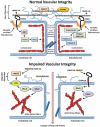Hyaluronan regulation of vascular integrity
- PMID: 22254199
- PMCID: PMC3253523
Hyaluronan regulation of vascular integrity
Abstract
Vascular integrity or the maintenance of blood vessel continuity is a fundamental process regulated, in part, by the endothelial glycocalyx and cell-cell junctions. Defects in endothelial barrier function are an initiating factor in several disease processes including atherosclerosis, ischemia/reperfusion, tumor angiogenesis, cancer metastasis, diabetes, sepsis and acute lung injury. The glycosaminoglycan, hyaluronan (HA), maintains vascular integrity through endothelial glycocalyx modulation, caveolin-enriched microdomain regulation and interaction with endothelial HA binding proteins. Certain disease states increase hyaluronidase activity and reactive oxygen species (ROS) generation which break down high molecular weight HA to low molecular weight fragments causing damage to the endothelial glycocalyx. Further, these HA fragments can activate specific HA binding proteins upregulated in vascular disease to promote actin cytoskeletal reorganization and inhibition of endothelial cell-cell contacts. This review focuses on the crucial role of HA in vascular integrity and how HA degradation promotes vascular barrier disruption.
Keywords: CD44; Endothelial permeability; HABP2; TLR2; TLR4; actin cytoskeleton; caveolin-1; caveolin-enriched microdomain; glycocalyx; versican.
Figures



References
-
- Dejana E, Tournier-Lasserve E, Weinstein BM. The control of vascular integrity by endothelial cell junctions: molecular basis and pathological implications. Dev Cell. 2009;16:209–221. - PubMed
-
- Luscher TF, Barton M. Biology of the endothelium. Clin Cardiol. 1997;20 II-3-10. - PubMed
-
- Singleton PA, Moreno-Vinasco L, Sammani S, Wanderling SL, Moss J, Garcia JG. Attenuation of Vascular Permeability by Methylnaltrexone: Role of mOP-R and S1P3 Transactivation. Am J Respir Cell Mol Biol. 2007;37:222–231. - PubMed
Grants and funding
LinkOut - more resources
Full Text Sources
Miscellaneous
